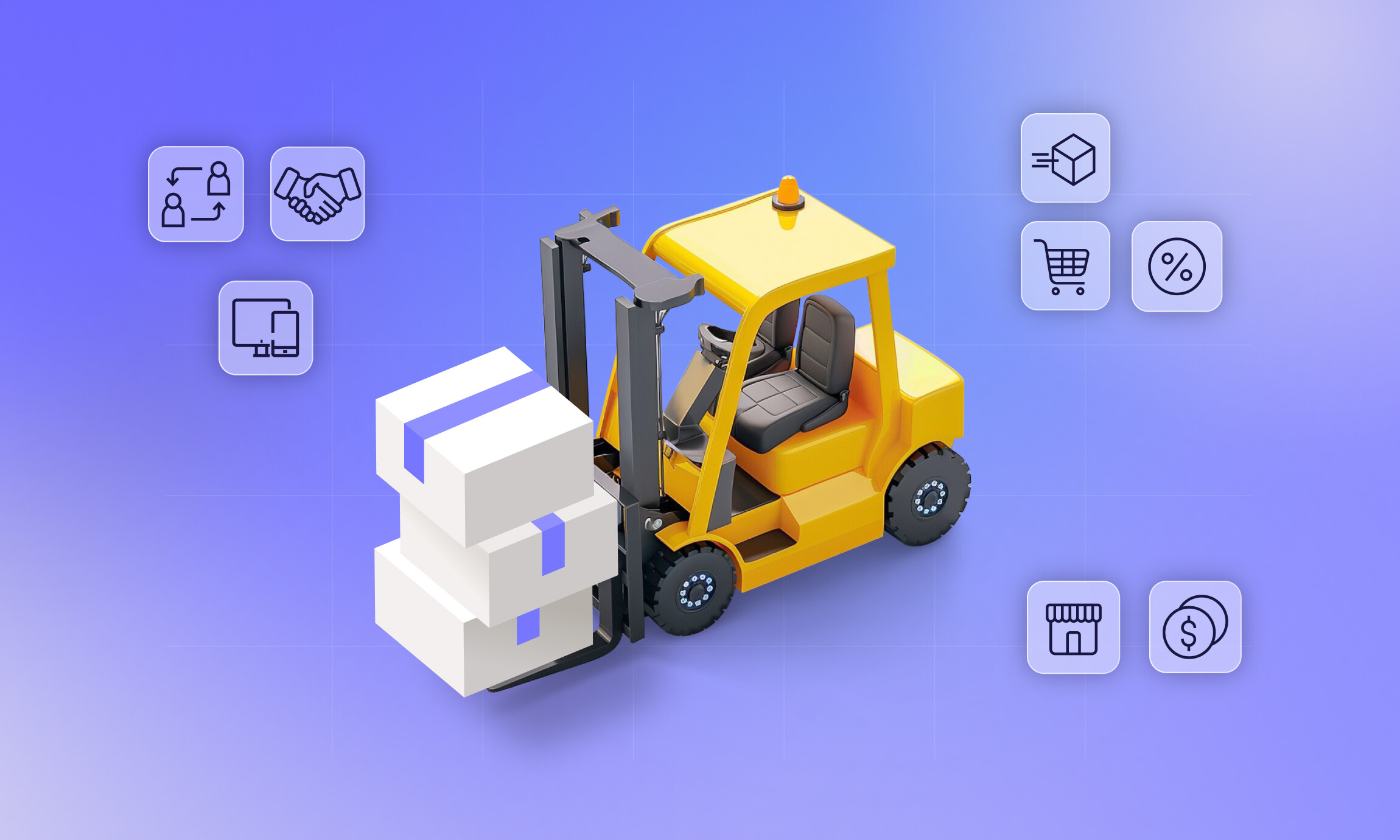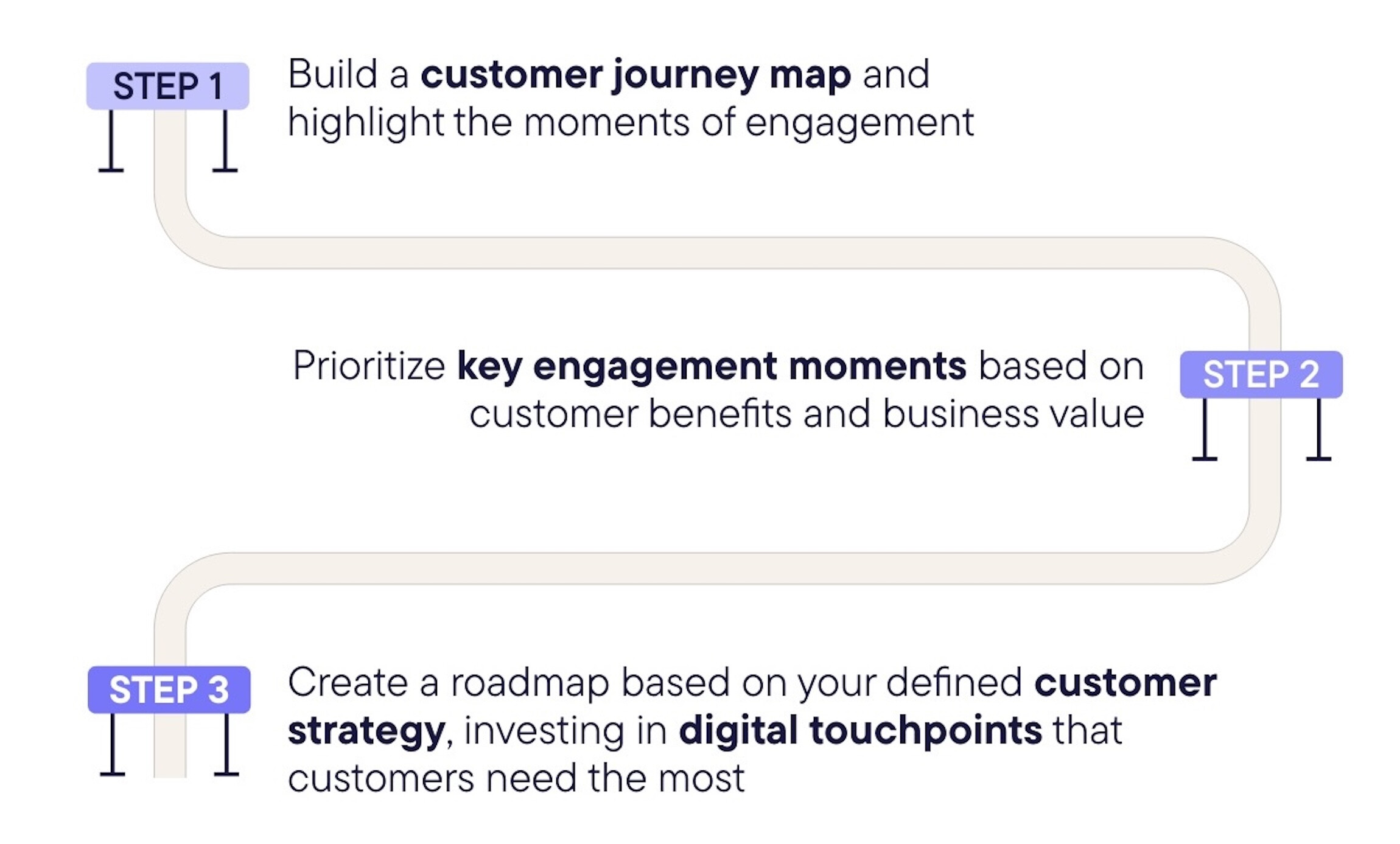
The customer obsession model is gaining momentum in B2B organizations. Explore what it truly means in B2B commerce — and the practical steps your business can take to make it a reality.

What’s a customer-obsessed model in B2B commerce?
B2B enterprises increasingly put their customers at the forefront and center of their strategy and operations. This customer-centric approach — or, as the market analyst firm Forrester calls it, “customer-obsessed” — is increasingly what manufacturers, distributors and wholesalers prioritize in their businesses.
The customer-obsessed model might sound obvious to leading B2B practitioners. Despite broad agreement on its importance, many B2B companies prioritize product or market category over the customer. Only in recent years has the “customer obsession” model emerged as the North Star for digital transformations across the B2B sector, fast proving that this strategy works.
In 2023, Forrester Research¹ reported that customer-obsessed B2B companies are twice as likely to report year-over-year revenue growth of 10% or more and profitability growth of 10% or more compared to less customer-focused peers.
Back then, Joe Cicman, Principal Analyst for B2B Commerce, said in a commercetools webinar that, “Truly customer-obsessed enterprises grew 1.6 times faster than their less mature peers. We measure the year-over-year revenue growth of enterprises around the world, and the success chasm is widening between businesses that are customer-obsessed and those that are not. That's why you obsess over your customers: so you can grow faster.”
According to a 2025 ANA report² citing Forrester data, customer-obsessed B2B companies report 28% faster revenue growth and 33% higher profit growth compared to companies that are not customer-obsessed. This underscores the growing financial imperative for B2B firms to prioritize customer obsession.
Yet many B2B companies still struggle to operationalize customer obsession. The answer? A combination of cultural transformation and future-fit technology. Joe Cicman noted, “To advance in customer obsession, you need to advance your technology strategy in lockstep.”
What’s the meaning of customer obsession in B2B?
Forrester defines customer obsession as placing the customer at the center of an organization’s leadership, strategy and operations. In the B2B context, this means going beyond traditional account management to create highly responsive, personalized and intelligent experiences for every stakeholder in the buying process.
Key markers of customer-obsessed B2B organizations include:
Continuous listening through direct customer engagement and frontline employee feedback.
Balancing AI-powered insights with the human touch for authentic, relevant personalization.
Cross-functional alignment around the customer journey, from marketing and sales to product and IT.
A clear strategy for acting on customer feedback and measuring its business impact.
Leadership is accountable for embedding customer-centric thinking across all teams.
In a world where B2B buyers increasingly expect the same intuitive, user-friendly digital experiences they get in B2C, customer obsession is emerging as a baseline requirement for growth.
How can B2B enterprises evaluate how customer-obsessed they are?
Companies of any size can leverage a customer-obsession model. As a starting point, business leaders can answer key questions to understand the state of customer obsession within their business, including:
Do your senior leaders adjust their perspective when customer insights challenge internal assumptions?
Is a C-level leader accountable for championing the customer perspective in strategic and operational decisions?
Are your products, services and experiences designed around real customer needs and behaviors?
Are offerings and experiences continuously refined based on customer feedback and market demand?
Does the business leverage data and insights to personalize experiences and anticipate customer needs?
Do you actively measure and connect customer loyalty, employee engagement and business performance to drive strategic improvements?
This self-evaluation is the first step in identifying blind spots and areas for improvement when pursuing a customer-obsessed model.
How can B2B enterprises engage customers to collect data and feedback?
Every decision should revolve around customer needs. After all, as customer behaviors and demands evolve, so must your buyer journeys and processes. To effectively involve customers, you can:
Conduct qualitative research: Interview key customers to understand their most significant friction points and expectations.
Leverage behavioral data: Analyze how customers interact with your current systems — where do they drop off, what features do they use most and what bottlenecks exist?
Run co-creation workshops: Bring together customers, product teams and business stakeholders to ideate solutions collaboratively.
Beta test new experiences: Offer select customers early access to new features and collect feedback before scaling.
Use customer advisory boards: Engage a dedicated group of customers to provide ongoing insights into how your digital transformation efforts impact their experience.
Engaging directly with customers and listening to feedback from your sales teams and customer support staff can shed light on pain points that may not be immediately visible in data alone.
What are the steps B2B enterprises can take to become customer-obsessed?
Putting the customer first in everything a company does sounds logical and straightforward, but the challenge is to bring this concept to life in a digital format that meets the demands of B2B buyers.
This is how your business can start mapping customer needs:

At this stage, you have already collected data on issues surrounding your customer journey by identifying friction points and direct customer feedback. The next step is to compare your current customer journey with the ideal experience your buyers expect. We recommend highlighting specific friction points or drop-offs, so it’s easier to visualize what’s working and what isn’t.
Furthermore, segmenting your customers by behavior, needs and purchasing patterns enables you to create more personalized strategies that address specific issues and drive stronger engagement and conversion.
This holistic understanding of your customer’s experience is essential for identifying the gaps that need to be addressed and the opportunities that can be leveraged to enhance satisfaction and drive business growth. For instance, this analysis can help you understand how to address untapped markets, such as tier 2 and tier 3 customers, which may open opportunities for new revenue streams if they can be tackled through digital channels.
Not all touchpoints are created equal. Some moments in the customer journey disproportionately impact satisfaction, loyalty and conversion. In this step, identify and prioritize these “moments that matter” by evaluating both customer benefit (e.g., reduced friction, emotional resonance, ease of use) and business value (e.g., increased revenue, retention, operational efficiency).
To do this effectively:
Map moments by impact and effort using a value matrix to focus first on high-impact, low-effort opportunities.
Assess pain points vs. delight moments to understand which parts of the journey frustrate users or exceed expectations.
Quantify value where possible, such as conversion rate uplift, NPS improvements or cost savings.
Once key moments are identified, define the underlying processes and systems required to support them. This could include reworking checkout flows, improving product discovery or streamlining returns. Document who owns each moment internally, and begin creating alignment across teams — marketing, product, IT, customer service — to ensure these moments are consistently delivered.
A successful roadmap strikes the right balance between speed to value and long-term scalability. Start by focusing on high-priority moments that can deliver measurable impact in the short term, such as improving search functionality, speeding up site load times, or adding a new payment method, while laying the groundwork for broader digital transformation.
Key actions at this stage include:
Define quick wins that can be rolled out to show immediate progress and gain internal momentum.
Identify foundational investments that enable agility and future capabilities, such as a headless CMS, customer data platform, or composable commerce architecture.
Estimate the potential business value of each initiative, including customer uptake, revenue contribution and operational efficiency.
Assess data and software needs for each prioritized digital moment. Determine where AI, automation or personalization can be layered for even greater impact.
Finally, ensure cross-functional alignment and build internal confidence by tracking success metrics, sharing early wins and refining your roadmap based on new insights and market dynamics.
Why does composable technology power the customer-obsessed model?
Technology is a means of business growth and should enable results. However, many organizations rely on technologies so outdated and rigid that they have become obstacles to innovation. While it’s understandable that B2B practitioners feel wary of swapping technologies after making significant investments in the past, postponing or scrapping the adoption of modern tech may prove detrimental to their bottom line in the long run.
Setting technology as an enabler for innovation — not an inhibitor — provides the foundation for successful digital transformation. As the age of the monolith comes to an end, embracing best-of-breed, composable technologies will greatly reduce the complexity of replatforming and virtually eliminate the need for versioned systems that require constant and expensive updates (think systems like SAP, Adobe/Magento and even newer systems like Shopify).
With composable commerce, the technology stack is more distributed. If issues arise (e.g., the ERP is down and your business still needs to collect orders), they are easier to contain, fix and continue to provide a seamless buying experience. In addition, you can release new features, touchpoints and improvements faster, benefiting your performance.
In conclusion, a composable approach to technology — where modular, flexible and interoperable solutions replace monolithic systems — allows organizations to quickly adapt to change, integrate new capabilities and scale efficiently.
As Joe Cicman, Principal Analyst at Forrester, noted, the composable approach allows “you to build and rebuild solutions so you remain differentiated.”
Real-world B2B leaders putting customers first
Here are success stories across various B2B organizations that have embraced customer centricity with a composable approach.
Tekton, a tool manufacturer known for digital innovation, realized that B2B customers expect the same frictionless experience as D2C shoppers. Their previous legacy platform couldn’t keep pace, especially when trying to add modern features like Apple Pay.
Switching to composable commerce allowed Tekton to unify its D2C and B2B experiences on the same modern architecture using composable commerce.
According to Jeff Amash, CIO at Tekton: “We moved to commercetools and built out our site based on that. And it was a pretty natural extension to realize our B2B customers expect the same kind of experience that a D2C shopper wants. They are used to shopping in really streamlined, easy ways. We realized within the last year that we could upgrade that whole side of our business as well, which drove us to build our site through commercetools for our B2B customers. And it’s been wonderful.”
Cepheid, a leading molecular diagnostics company, needed to modernize its digital capabilities to better support hospitals and labs with real-time ordering and inventory tracking. Using a composable approach, the company built new digital services quickly and precisely, reducing fulfillment friction during critical supply chain moments.
In only six months, Cepheid underwent a digital transformation process that created MyCepheid, a portal for B2B buyers with a personalized dashboard, where they can quickly access and manage orders, invoices and shipment information, as well as view open cases. There’s even a “Buy Again” widget to expedite reordering of previously ordered items. On the support side, customers can manage their equipment, check service history, review warranty information/expiration dates and connect with customer service experts.
Moreover, the Cepheid online store features a complete inventory of field tests and collection devices. Designed for speed, customers can quickly and easily check product availability, view their contract prices and get estimated delivery dates. “Our customers can complete their order with a single page checkout. On average, an order can be completed in as fast as two minutes,” revealed Amelita Ebuña, Director of eCommerce.
As a distribution company focused on serving small businesses in Chile, Adelco has long thrived by taking a personal approach to sales. Sales representatives play a crucial role in the business, managing orders through direct visits to points of sale.
One of the main benefits Adelco has realized since implementation is a more comprehensive view of data. With commercetools’ API-first design, the company can more easily identify which features resonate with customers. With this insight, Adelco leveraged the flexibility of composable to enhance the customer and sales representative’s experiences. Since then, Adelco has increased eCommerce sales by 400% and augmented SKUs per order for self-service customers by 25%.
“We embarked on transforming the traditional sales channel, a project that involved several stages, including digitalization and adapting to consumers’ changing behaviors during the pandemic. Having business and technology teams working together was crucial to accomplish that goal,” said Carolina Pinto, Chief Commercial Officer at Adelco.
Customer obsession is the new standard
Customer obsession is now the cost of entry for competitive B2B businesses. It will be how companies grow faster and retain customers longer.
Composable commerce is not the only solution, but it is a powerful enabler for any organization ready to consistently put customers at the center.
Ready to explore what composable commerce can unlock for your B2B digital transformation?
